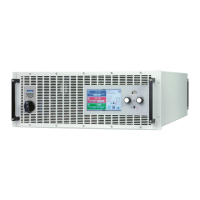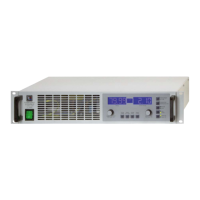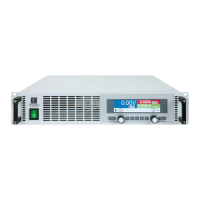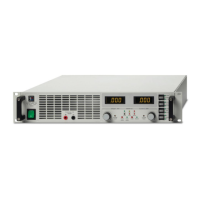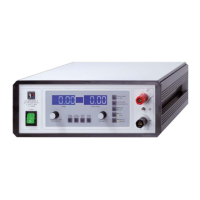Page 77
EA Elektro-Automatik GmbH
Helmholtzstr. 31-37 • 41747 Viersen
Germany
Fon: +49 2162 / 3785-0
Fax: +49 2162 / 16230
www.elektroautomatik.de
ea1974@elektroautomatik.de
PSB 9000 3U Series
3.11.8 Trapezoidal function
The following parameters can be congured for a trapezoidal curve function. Following applies:
• There is no preselection to which of both, source mode and sink mode, the function is applied to; the settings
decide whether it is “source mode only”, “sink mode only” or a mixture of both
• When applying the function to the voltage, the device can only switch to and work in sink mode if the external
voltage on the DC terminal is higher than the highest point (oset + amplitude) of the wave and the current set-
ting “I Sink” is not 0
Value Range Description
U(A), I(A) 0...(rated value - [Os]) A = Amplitude of the signal to be generated
U(Os) 0... (U
Nom
- A)
Os = Oset, based on the foot of the trapezium
I(Os) - (I
Nom
- A)...+(I
Nom
- A)
t1 0.1 ms...36000 s Time for the positive slope of the trapezoidal wave signal.
t2 0.1 ms...36000 s Time for the top value of the trapezoidal wave signal.
t3 0.1 ms...36000 s Time for the negative slope of the trapezoidal wave signal.
t4 0.1 ms...36000 s Time for the base value (=oset) of the trapezoidal wave signal
Schematic diagram: Application and result:
t
A
Amplitude
t1t2 t3 t4
Same as with other functions the generated signal can be
applied to the set value of voltage (U mode) or to the cur-
rent (I mode). The slopes of the trapezium can be varied by
adjusting the times for rise and fall separately.
The periodic duration and repetition frequency are the result
of the four adjustable time values. With suitable settings the
trapezium can be deformed to a triangular or rectangular
wave. It has, therefore, universal use.
3.11.9 DIN 40839 function
This function is based on the curve dened in DIN 40839 / EN ISO 7637 (test impulse 4), and is only applicable
to voltage. It shall replicate the progress of automobile battery voltage during engine starting. The curve is divided
into 5 sequences (see diagram below) which each have the same parameters. The standard values from the DIN
are set already as default values for the ve sequences.
Typically, this function is used with power supplies (here: source mode), but can also be used with electronic loads
(here: sink mode). However, the device can only switch to and work in sink mode if the external voltage on the DC
terminal is higher than the highest point (oset + amplitude) of the wave and the external source cannot deliver
more current than adjusted for sink mode (I sink). Else the device could regulate the voltage values resulting from
the curve. The global set values can furtheremore clearly dene in what operation mode the function is run.
The following parameters can be congured for the single sequence points or the entire function:
Value Range Seq Description
Ustart 0...U
Nom
1-5 Start voltage of the ramp
Uend 0...U
Nom
1-5 End voltage of the ramp
Seq.time 0.1 ms...36000 s 1-5 Time of the ramp
Seq.cycles ∞ or 1...999 - Number of repetitions of the entire curve
Time t1 0.1 ms...36000 s - Time after cycle before repetition (cycle <> 1)
U(Start/End) 0...U
Nom
- Voltage setting before and after the function run
I/P Source 0...I
Nom
/P
Nom
- Global set values for current and power. If either I=0 or P=0, the
device would only work in sink mode
I/P Sink 0...I
Nom
/P
Nom
- Global set values for current and power. If either I=0 or P=0, the
device would only work in source mode
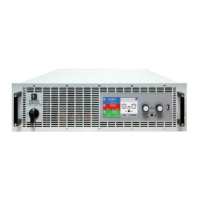
